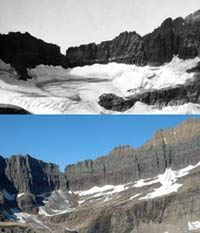Glaciers Disappear in Before & After Photos

Glacier National Park might soon need a new name.
The Montana park has 26 named glaciers today, down from 150 in 1850. Those that remain are typically mere remnants of their former frozen selves, a new gallery of before and after images reveals.
All arguments about global warming aside, now is a time of clear retreat by age-old ice packs in many locations around the world. Some retreat just a few inches or feet per year, but others are melting faster than a snow cone in Texas.
80 feet per day
Montana might not be the first place that comes to mind when you think of glaciers. Elsewhere, however, the situation is similar.
The Columbia Glacier in Prince William Sound, the world's fastest-melting glacier, slides into the ocean at a rate of 80 feet per day. This tidewater glacier is up to 3,000 feet thick, but it has thinned up to 1,300 feet in places during the past 25 years, and researchers say it's stretching like taffy. Each year, it dumps 2 cubic miles of ice into the sound.
In Greenland it's not uncommon nowadays for glaciers to recede several miles in one year.
Sign up for the Live Science daily newsletter now
Get the world’s most fascinating discoveries delivered straight to your inbox.
Fast or slow, the melting is usually a gradual process compared to, say, a flooded, rushing river. But sometimes glaciers can weaken to the point where they suddenly, and noisily, collapse. One dramatic example of a quick break is the Larsen B ice shelf in Antarctica (this collapse also revealed a surprisingly thriving underwater world).
Along with glacial melting, permafrost around the globe is turning to mush, causing ground to simply collapse.
All this melting might lead one to believe that land is being freed up, but a new study suggests just the opposite. Melting glaciers, a result of global warming, could cause sea levels to rise as much as three feet per century, submerging coastal regions.
Summers in parts of the Arctic could be ice free in the next 100 years, which could prove daunting for the existence of polar bears.
Closer to home
Ice in Glacier National Park is also disappearing.
In 1997 the U.S. Geological Survey began the Repeat Photography Project in the Montana park to compare how glaciers have changed over the last century. Photographers returned to locations where old-timers had taken photos long before they could possibly have imagined their scientific value. Locating these vantage points was the trickiest part of the project, as some required extensive off-trail hiking.
The before and after pictures [Gallery] released this week are dramatic—all that remains of some glaciers are big puddles. Others have simply faded away to expose bare mountainsides. The images were taken at similar times of year under similar conditions.
Based on the pictures and global recession rates, scientists predict that the park will be glacier free by 2030.
While global warming gets most of the blame for glacier recession, soot pollution from automobiles and industrial chimneys might also play a role. Clean, shiny ice reflects sunlight and remains cool. But dirty, soot-covered ice absorbs more warmth from the sun, causing a glacier to melt more quickly.
The Global Warming Controversy
- Conflicting Claims on Global Warming and Why It's All Moot
- Baffled Scientists Say Less Sunlight Reaching Earth
- Scientists Clueless over Sun's Effect on Earth
- Key Argument for Global Warming Critics Evaporates
The Effects
- Seas to Rise
- Ground Collapses
- Allergies Get Worse
- Rivers Melt Sooner in Spring
- Increased Plant Production
- Animals Change Behavior
- Hurricanes Get Stronger
- Lakes Disappear
The Possibilities
- More Rain but Less Water
- Ice-Free Arctic Summers
- Overwhelmed Storm Drains
- Worst Mass Extinction Ever
- A Chilled Planet
Strange Solutions
Good-bye Tribute

Glacier Facts
About 10 percent of Earth's land is covered with glaciers.
During the last Ice Age, glaciers covered 32 percent of land.
Glaciers store about 75 percent of the world's fresh water.
Antarctic ice is more than 2.6 miles (4,200 meters) thick in some areas.
If all land ice melted, sea level would rise approximately 230 feet (70 meters) worldwide.
SOURCE: NOAA
